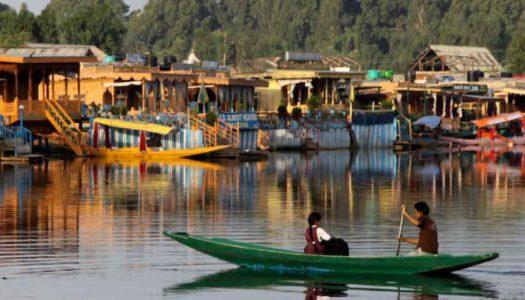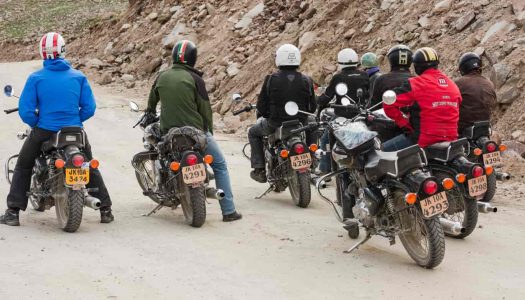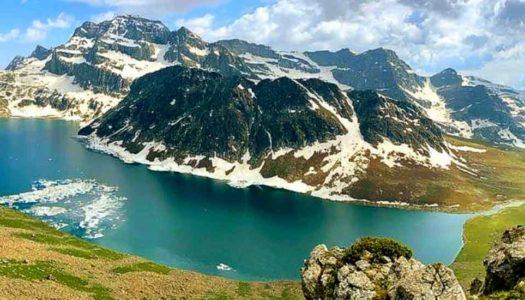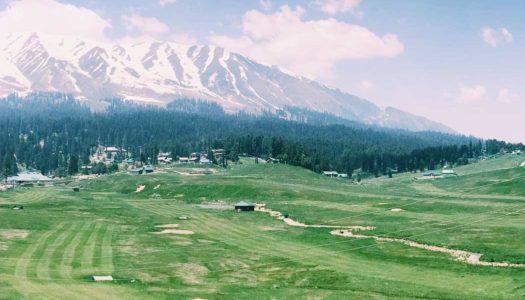The Jammu Srinagar Railway Line is a remarkable example of human engineering ability intertwined with the natural beauty of Jammu and Kashmir, India. The line connects Jammu, Srinagar, and Baramulla, and allows passengers to take a wonderful trip. It is one of the most beautiful train routes in India as it passes through beautiful lands, the majestic Himalayas, lush valleys, and thick forests.

The railway line, approximately 345 km, is much more than a piece of infrastructure; it is a bridge to bring people and communities closer, a sign of progress and unity in an area with rich cultural diversity. Most importantly, the railway line gives major places to visit in Srinagar a tourism boost by facilitating easier transport and making it reliable and more efficient.
History Behind the Jammu Srinagar Railway Line
The Jammu Srinagar Railway Line project began in the early 1980s, and progress has encountered serious delays due to the rugged terrain and extreme weather in the region. State-of-the-art technology, modern bridge-building techniques, weatherproofing and seismic-resilient infrastructure were used to make this proud landmark a reality.
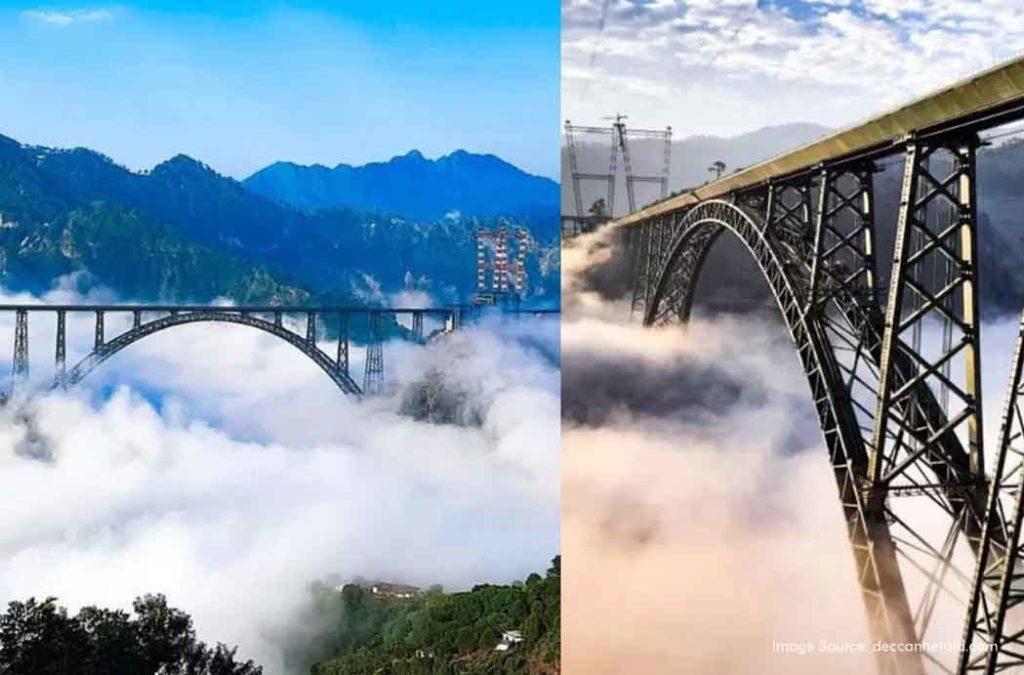
Major Milestones of the Jammu Srinagar Railway Line
- The idea of a railway line connecting Rawalpindi and Srinagar has a history dating back more than a hundred years (1902 and 1905).
- With the division of India/Pakistan in 1947, Jammu lost its rail link to India until the Pathankot-Jammu line was commissioned in 1975.
- The Jammu-Udhampur line was started in 1983 but languished with delays.
- The project was completed in 2004, after 21 years and at 10 times the original estimated cost.
- The Udhampur-Srinagar-Baramulla Rail Link (USBRL) project was declared a national project in 2002
The Scenic Locations along the Enchanting Jammu Srinagar Railway Line
Apart from being an important transportation link for local people, this railway line is an attraction for tourists wishing to see this amazing part of Northern India. Here are some of the major mesmerising views you get to witness while taking the Jammu Srinagar Railway Line.
- Chenab Bridge: The highlight of this route is the amazing Chenab Bridge, which is the highest railway bridge in the world. Standing 359 meters high above the riverbed and measuring 1,315 meters long, it is quite an accomplishment of modern engineering. The views from the Chenab Bridge are really stunning. You get a real feel of the towering cliffs surrounding the railway line and the depth of the Chenab River below.
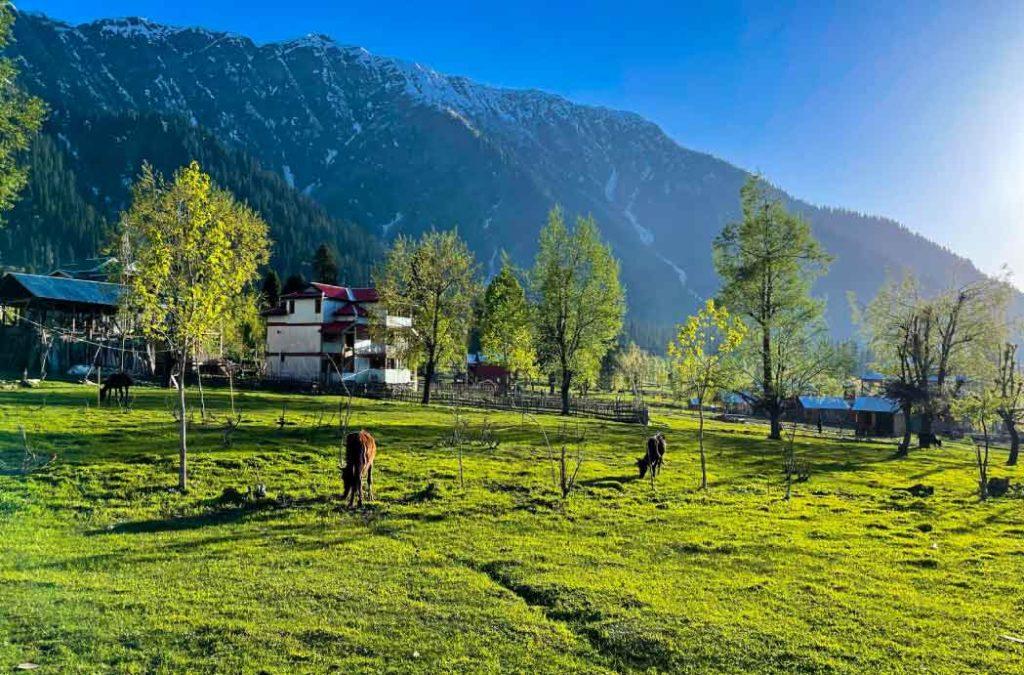
- Qazigund Tunnel: Travellers will witness wonderful tunnels and bridges along the Udhampur to Banihal route. There is a special sense of accomplishment traversing along the Banihal – Qazigund Tunnel, India’s longest railway tunnel, measuring 8.45 km long. When you are in this tunnel, you will appreciate the effort that went into cutting this tunnel through an extremely difficult natural resource area linking the Kashmir Valley to India.
- The Kashmir Valley: Upon exiting the Banihal tunnel, you will find yourself in the captivating Kashmir Valley, a paradise with incredible landscapes and cultural richness. As the train draws closer to Srinagar, you will get to see iconic terrains – lush green meadows, sacred rivers, and the beauty of snow-capped hill stations in Jammu and Kashmir.
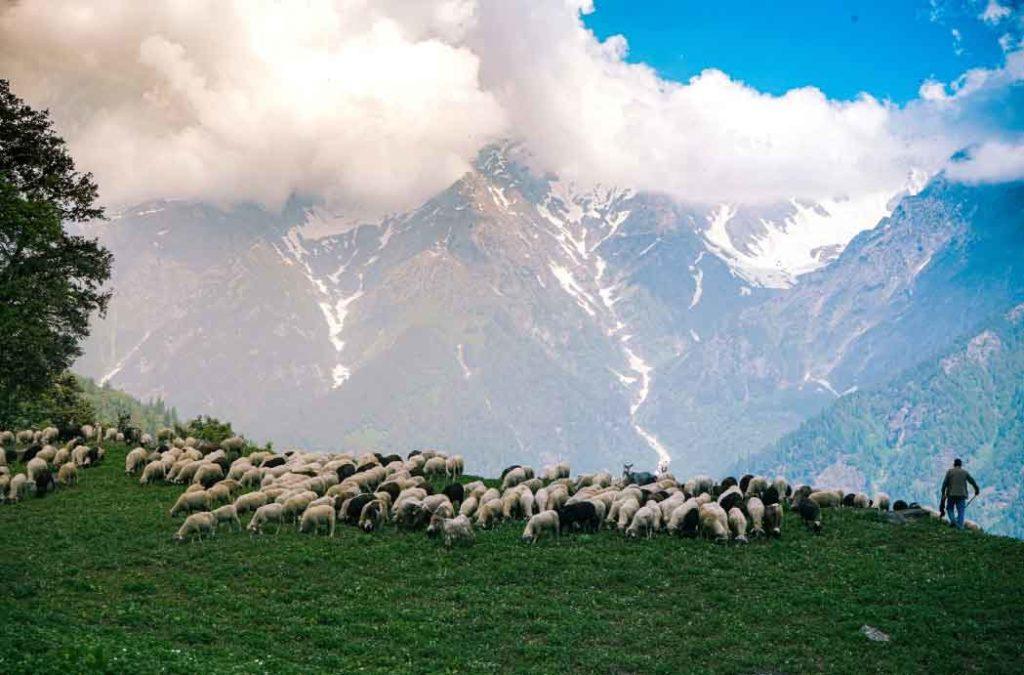
- Baramulla: The Jammu-Srinagar railway line then continues to Baramulla, offering a real glimpse into the nature and culture of the Kashmiri people with saffron fields and apple orchards. For tourists, hotels in Srinagar are a top choice. The hotels are located just 100 mts from the River Jhelum. You could hop on a bicycle and explore the nearby attractions at your own pace.
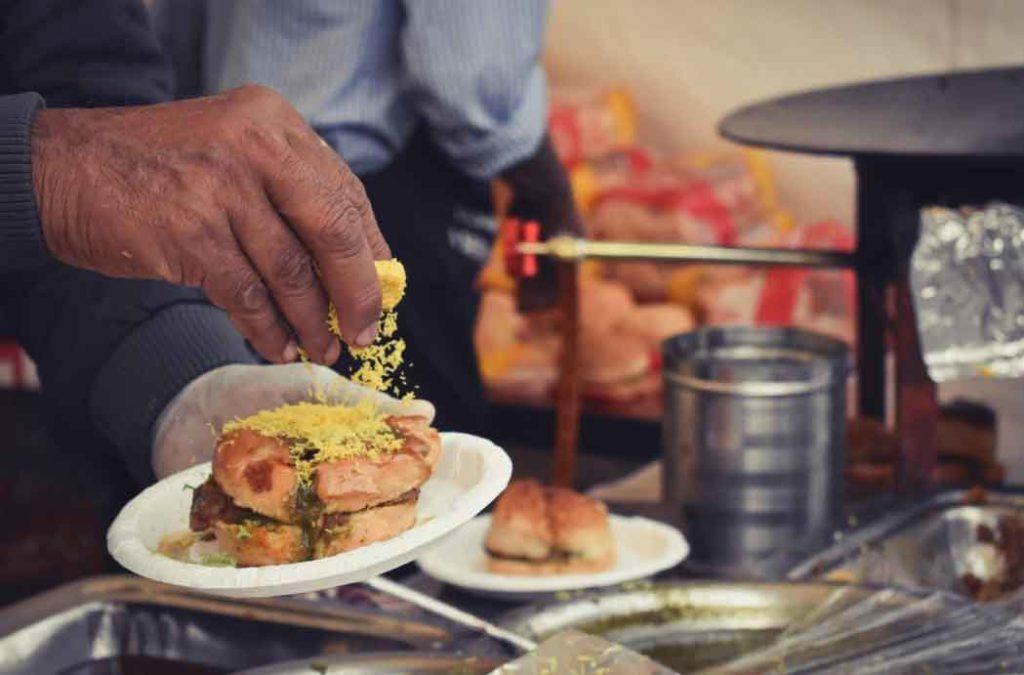
Flagship Vande Bharat Express Project on Jammu-Srinagar Railway Line
The Udhampur-Srinagar-Baramulla Rail Link Project (USBRL) has greatly improved the connection between Jammu and the Kashmir valley. Until recently, visitors could not reach Srinagar directly by train. They had to travel to Banihal and take a two-hour ride to Srinagar. With the track finished and milestones met, the Indian Railways has initiated operations with 2 Vande Bharat Express trains and is already carrying regular passengers along the new route directly to Srinagar.
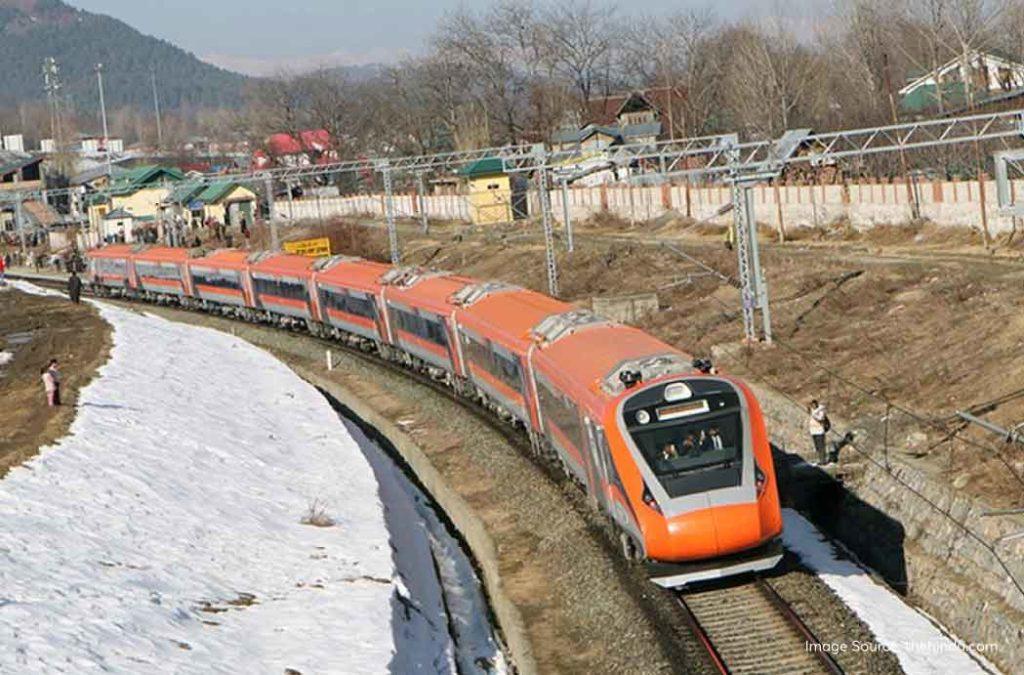
The Vande Bharat Express, with its modern design and high speed, offers a seamless travel experience. If you enjoy exploring places by train, you must try the various luxury trains in India. The Vande Bharat Express is set to serve two routes, one from Shri Mata Vaishno Devi, Katra, to Srinagar and the other from Srinagar to Jammu Tawi. The first semi-high-speed service from Katra to Srinagar has already been initiated to provide a new, reliable, direct and comfortable travel experience for this high-demand travel. This will cut down travel time from 6-7 hours to just 3 hours.
Major Stations along the Exquisite Jammu Srinagar Railway Line
The route of the Jammu Srinagar railway line service is breathtaking, with 7 important stations along its way. Its major stops (in order) are:
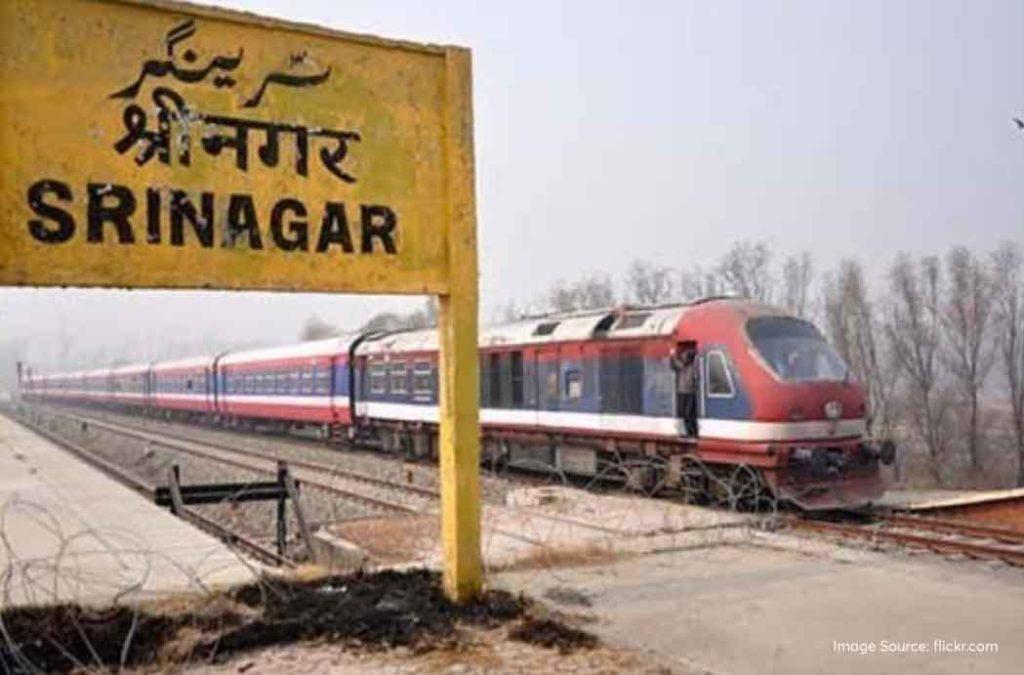
- Jammu Tawi: This is the first station and marks the start of your mesmerising journey to the Kashmir Valley. It is a key station that connects long-distance trains from across India. The Jammu Tawi station offers various facilities like waiting rooms, restaurants and booking offices for the ease of travellers. It is a cultural hub to many religious sites, which people on pilgrimage to the Vaishno Devi shrine often visit before starting their journey.
- Udhampur: Located amongst the lush green landscapes and hilly terrain, Udhampur is an important access point to the Kashmir Valley. The Udhampur Railway Station has all the modern facilities to accommodate the high-density footfall of rail passengers and freight logistics. Its location makes it an important strategic transportation route that facilitates new economic opportunities for nearby towns and villages. This will significantly promote tourism and lead to socio-economic growth of the region.
- Katra, Shri Mata Vaishno Devi Station (SVDK): Katra is the primary gateway for pilgrims visiting the sacred shrine of Vaishno Devi. The station is located between beautiful hills and valleys in the Trikuta Mountains. It is well equipped to sustain the endless stream of devotees visiting the shrine all throughout the year. The new train connection at Katra has provided easy travel access to all religious tourists. There are hotels in Katra where visitors can stay and explore the local crafts and street markets.
- Sangaldan: Nestled among beautiful mountains, Sangaldan displays the region’s natural beauty in its purest form. Trains along this little hamlet whisk by as passengers glance through the rolling green landscapes with a rural backdrop. The picturesque tree-covered hills, sparkling streams with twisting trails and dense forests all come together beautifully in this quiet region. Sangaldan conveys the full value of the Jammu-Srinagar Railway Line Project, as it is a unique journey characterised by unbelievable scenic landscapes where nature and human efforts converge.
- Banihal: A significant town located in the deep and beautiful Pir Panjal range, Banihal is a crucial point on the Jammu-Srinagar railway line. The railroad is eye-catching with majestic views of the snow-capped Himalayan peaks and valleys. The “Pir Panjal Railway Tunnel”, also known as the “Qazigund Tunnel”, is one of the longest railway tunnels in India, and cuts straight through the heart of the Pir Panjal range. The railway line has been designed to withstand snowfall and landslides so people can have safe travel during any season.
- Avantipur: Situated in the heart of Jammu and Kashmir, Avantipur is becoming an emerging tourism destination, primarily due to its historical significance. It is home to the ruins of the Avantipur Temple Complex, constructed in the 9th century A.D. This is a grand evidence of Kashmir’s historical past. Founded by King Avantivarman, the historic sites provide tourists a brief insight into the regional identity of their cultural heritage. This ethnicity, coupled with exquisite scenery, makes Avantipur a great place for tourism on the Jammu-Srinagar railway line.
- Srinagar: The last stop on the Jammu-Srinagar railway line is a gem in itself, renowned for its beauty and culture. Srinagar, located in the heart of the Kashmir valley, offers a spectacular view of the peaceful Dal Lake adorned with Shikaras and Houseboats. The spellbinding Mughal gardens truly define the beauty of this region. The culture of this city is lively and meaningful, with old shops where the renowned Pashmina shawls and beautiful woodwork are made and sold by fine craftsmen. The Jammu-Srinagar railway line provides direct access to its culture, expands its economic health, and makes it easily reachable to a wide range of people.
Train Timings:
- Departure from Shri Mata Vaishno Devi Station: 08:10 AM
- Arrival at Srinagar: 11:20 AM
- Departure from Srinagar: 12:45 PM
- Arrival at Shri Mata Vaishno Devi Station: 03:55 PM
Ticket Pricing:
- AC Chair Car: ₹1,500 – ₹1,600
- Executive Chair Car: ₹2,200 – ₹2,500
Tips for Train Travel on the Jammu Srinagar Railway Line
Taking the Jammu-Srinagar railway line is a very scenic and efficient way to travel through the amazing sights of Jammu and Kashmir. To make your train travel enjoyable and comfortable, here are some travel tips:

- Book Your Tickets in Advance: As the Jammu to Srinagar train service is going to be very popular, especially the Vande Bharat Express train, you should try to book your tickets as early as you can if you want to get the date and class of your choice. You can book directly through the IRCTC reservation portal or through a recognised travel agent.
- Stay Alert with Time Table and Schedule Changes: Timing is important, as the Jammu Srinagar railway line schedules change sometimes due to unexpected weather conditions. The trip should take 3 hours and 10 minutes, which is much quicker than travelling by road. You should plan carefully to make the most of your travel day, as it depends on your arrival and departure timings.
- Dress for All Weather Conditions: When packing, keep note that the weather conditions in Jammu and Kashmir do change. If you are travelling during the colder winter months, you will need extra warm clothing to manage the cold temperature.
- Make Sure You Capture the Scenery: You will see some beautiful Himalayan scenery and culturally important landscapes along the way. Make sure your camera is ready to capture these opportunities along the way. If possible, choose a window seat.
- Be in Alert Mode with Safety and Security: Ensure that your belongings are kept secure. Place bags on the luggage rack and make sure they are named and locked for safety. During your travel, be aware of your surroundings and immediately report any suspicious behaviour to the train staff.
- Charging Electricity and Connecting Wifi: You will likely have access to charging ports and wifi facilities on modern-day quality trains on the Jammu Srinagar railway line. Always keep your phones charged so that you can stay in touch or keep yourself engaged during your journey.
- Transportation at Your New Arrival Destination: Plan your transportation arrangements ahead of time based on your arrival time. You should familiarise yourself with your local travel options and their availability at your destination. This will ensure your transition from the railway station to the nearby hotels in Srinagar is hassle-free.
Best Times to Visit Jammu
The best time to visit Jammu is all year round, as each season offers a unique experience. Schedule your trip to match the season below that aligns with your interests.
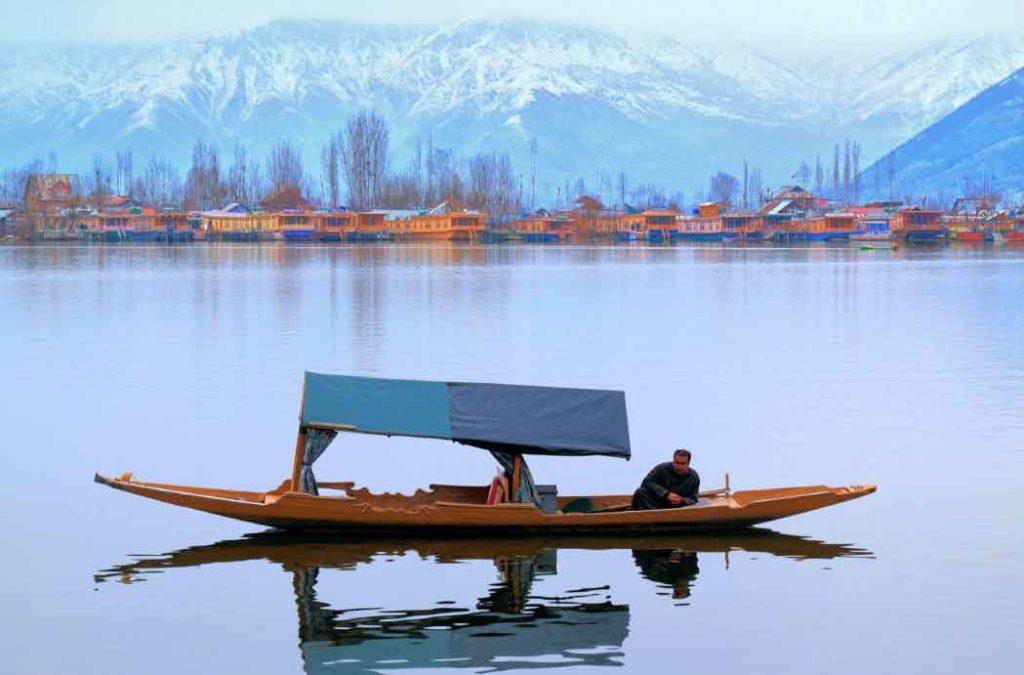
December to February (Winter): Winter in Jammu can be chilly, with night temperatures falling below 4 degrees Celsius. This is the best time to visit the Jammu region to enjoy winter sports and activities at higher altitudes. The long-anticipated Jammu-Srinagar railway line service is here, which will make travel easier and enhance the overall experience.
March to May (Spring): Spring is one of the best seasons to visit Jammu, as the valleys and fields burst into bloom and life. The weather is also pleasant with temperatures around 15 – 25 degrees Celsius.
June to August (Summer): Although it is summer, and the temperatures can reach up to 30 degrees Celsius, Jammu is less hot than the rest of the cold places in India. Summer is a great time to visit the higher altitude places and hill stations near Jammu, such as Patnitop and Sanasar.
September to November (Autumn): In autumn, the foliage of the leaves turns brown, gold, yellow, and red all at once. The weather during autumn is quite comfortable, with temperatures ranging from about 20 degrees Celsius to about 30 degrees Celsius. These months are great for sightseeing and enjoying outdoor activities.
The hotels in Jammu are centrally located and well-connected, which will reduce your travel time significantly while exploring nearby attractions.
Make the Most of This Journey to the “Winter Wonderland”
Travelling along the Jammu-Srinagar Railway Line is not simply a ride – it is an experience of a lifetime, travelling through one of the most beautiful parts of the world – a combination of man-made and natural marvels. Always pre-book your stays in advance with Treebo Club hotels in the region. Remember to follow the travel tips mentioned above, you will have a hassle-free trip.








